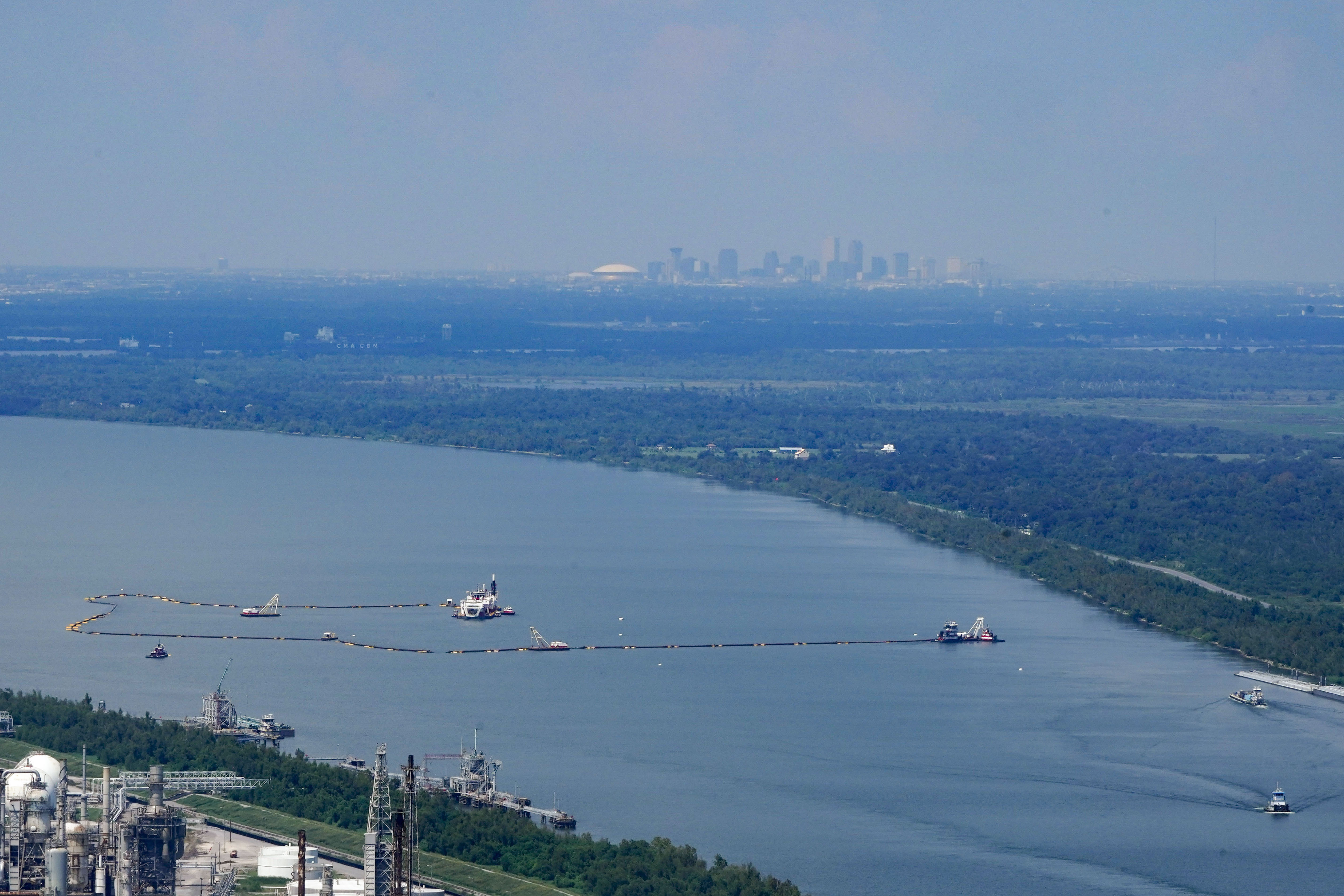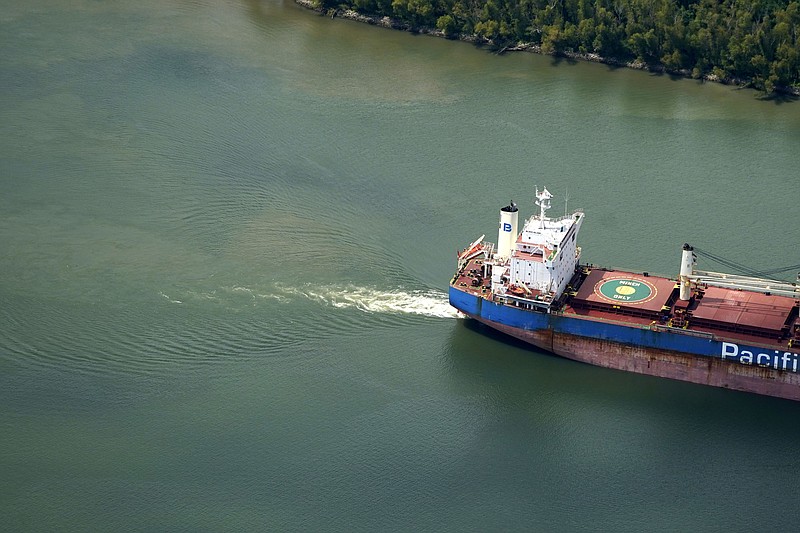NEW ORLEANS -- Salt water showing up in South Louisiana taps is drawing a flood of complaints from residents who blame officials for not taking action until the water began posing a threat to more populated areas.
Byron Marinovich is one of those upset in Plaquemines Parish, saying it's creating a problem for his business, the Black Velvet Oyster Bar and Grill.
"We're draining the hot water heater every few days to get most, or a good bit, of the salt out of that," Marinovich said. "The ice machine has been off since the third week of April."
The heating element removed from Monique Plaisance's water heater in September was disintegrating, streaked with rust and covered in a dry crust. She blamed the corrosion on the water piped in from the Mississippi.
Plaisance's home and Marinovich's restaurant are in the Buras community, roughly 60 miles southeast of New Orleans and 20 to 30 miles upriver from where the Mississippi flows into the Gulf of Mexico. As in New Orleans, drinking water in the parish is drawn from the river.
But this year, the Gulf pushed back. A wedge of salt water slipped up along the river bottom, beginning in the spring. By early October, water intakes at towns such as Boothville, Port Sulphur and Pointe a la Hache had been inundated.
Plaquemines Parish officials list a variety of measures they've taken to provide drinkable water to residents in the southeastern part of the parish, which juts into the Gulf. Trucks of bottled water for drinking and barges full of freshwater to dilute the salt water before it goes into intakes are among the solutions.
Advisories against drinking tap water were lifted Oct. 18.
Plaisance and Marinovich are among residents who think remedial efforts began too late. They say no action was taken until the water began posing a threat to more populated areas including the city of Belle Chasse, which is at the parish's northernmost end and home to more than 10,000 people, roughly half the population of the mostly rural parish.
"We've been working on this since June the 19th," Parish President Keith Hinkley said in a telephone interview. "We have not drug our feet. We moved as fast as we could in getting these projects up and running. We made a decision to get a water station, water plant, back up and running that had been down for two years. We got it back up in a position to start producing water in somewhere between six to eight weeks."
CONTRIBUTING FACTORS
Authorities cite multiple factors for the saltwater intrusion. Most prominent this year has been a drought across the Midwest that has meant less water flowing into the Mississippi and the rivers feeding it.
At Vicksburg, Miss., north of New Orleans, the river flowed at a rate about 50% slower and at a stage height about 95% lower than normal during late September and early October between 2013 and 2022, according to analysis of data from the U.S. Geological Survey.
Parts of Kansas, Nebraska, Missouri, Iowa, Minnesota and Wisconsin -- all part of the vast Mississippi River basin, which touches 31 states -- are experiencing extreme drought conditions. Rainfall amounts are down in the watershed of the Ohio River, which contributes half of the Mississippi's flow reaching new Orleans.
Another factor is dredging, according to Stephen Murphy, an assistant professor at Tulane University's School of Public Health and Tropical Medicine and the director of the university's Disaster Management Program. The lower Mississippi is frequently dredged by the U.S. Army Corps of Engineers to make way for huge cargo ships serving ports vital to the Louisiana and national economies.
The lower, slower river flow and a deep, wide river channel set the stage for Gulf water to push inland.
Earlier in the fall, projections that the salt water would reach the New Orleans area by late October prompted residents to stock up on bottled water while public officials undertook emergency preparations as though there were a slowly approaching hurricane.
In Jefferson Parish, next to New Orleans, officials began laying out flexible piping resembling giant fire hoses in a plan to pipe water from farther up the Mississippi to dilute the salt water.
New Orleans officials also were working on a plan to build an emergency pipeline. The hope was that much of the projected cost, as high as $250 million, would be covered by the federal government under a presidential emergency declaration issued in September.
Updated projections have negated the need for the measure. The more favorable river forecasts are a result of various factors, including the Corps' construction of what amounts to an underwater dam in Plaquemines to impede saltwater progress. Recent rains in western Louisiana also have been a factor.
ALARM BELLS SOUND
While the threat to the New Orleans area has been diminished, local leaders say it's a wake-up call.
"If this is what we're going to be facing every couple of years, we certainly want to make an investment in how to solve this problem," Jefferson Parish President Cynthia Lee Sheng said.
This is the fifth year the Corps has built an underwater structure to slow the saltwater flow. But this is the first time sill construction has been used in consecutive years. Before last year, others were built in 1988, 1999 and 2012.
Rising seas portend more problems. The sea level around New Orleans is rising at a rate of as much as 0.35 inch per year, or 3 feet each century, much higher than the global average and the highest rate measured in the United States, according to experts at the National Oceanic and Atmospheric Administration's Center for Operational Oceanographic Products and Services.
"My worry is we continue to experience these low river flow rates and have a repeat occurrence year after year after year. And at some point I worry that that saltwater wedge could creep further upriver and then we would be finding ourselves in the same predicament upriver as we are right now in the city," said Murphy, the assistant professor.
In the New Orleans area, permanent pipelines to draw water from upriver have been discussed. But Murphy doesn't think pipelines are the solution. Instead, large-scale reverse osmosis filtration systems may be the answer, Murphy said. He pointed to Tampa Bay, Florida, as an example of where desalinization is used for drinking water and said Gulf Coast communities should collaborate to find ways to safeguard water systems.
It also may be time to hold regional meetings to discuss the threat, Murphy said.
"Maybe we should all start partnering together, much like we do for hurricane conferences," he said. "Maybe we should be talking about climate change conferences."
Information for this article was contributed by Mary Katherine Wildeman and Camille Fassett of The Associated Press.
 FILE - In this aerial photo, dredging operations to build an underwater sill are seen, with the city of New Orleans in the background, Sept. 26, 2023, in Plaquemines Parish, La. Salt water from the Gulf of Mexico has caused problems for water systems in Plaquemines Parish. Fears that it would reach New Orleans' water intakes have abated amid improved forecasts, but officials in the area say the threat could return in years to come as climate change, sea level rise and dredging of the river for commercial traffic all could contribute to salt water intrusion. (AP Photo/Gerald Herbert, File)
FILE - In this aerial photo, dredging operations to build an underwater sill are seen, with the city of New Orleans in the background, Sept. 26, 2023, in Plaquemines Parish, La. Salt water from the Gulf of Mexico has caused problems for water systems in Plaquemines Parish. Fears that it would reach New Orleans' water intakes have abated amid improved forecasts, but officials in the area say the threat could return in years to come as climate change, sea level rise and dredging of the river for commercial traffic all could contribute to salt water intrusion. (AP Photo/Gerald Herbert, File)